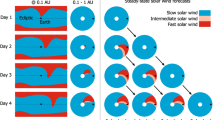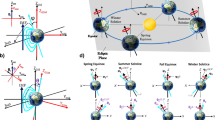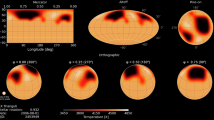Abstract
THERE is still no satisfactory method of predicting sunspot activity beyond the current cycle, but two recent papers have provided new evidence that sunspot activity may be controlled by the positions of the planets. This possibility was discussed more than 50 years ago by Brown1, and later by Schuster2, and was adopted as a basis for prediction by others. The recent evidence has been provided by Jose3 and by Wood and Wood4. Jose3 has shown that the rate of change of the angular momentum of the Sun about the centre of mass of the solar system exhibits a 178-year periodicity which can plausibly be correlated with sunspot activity. Jupiter and Saturn are the planets mainly responsible. Wood and Wood4 have suggested that the rate of change of angular acceleration of the Sun, which is controlled mainly by the inner planets, shows resemblances in detail to the sunspot numbers. These new results, although not immediately useful in predicting solar activity, do point towards the conclusion that variations in solar activity have a causal basis. If so, an empirical law for the variation of sunspot numbers should eventually be found.
This is a preview of subscription content, access via your institution
Access options
Subscribe to this journal
Receive 51 print issues and online access
$199.00 per year
only $3.90 per issue
Buy this article
- Purchase on SpringerLink
- Instant access to full article PDF
Prices may be subject to local taxes which are calculated during checkout
Similar content being viewed by others
References
Brown, E. W., Mon. Not. Roy. Astronom. Soc., 60, 599 (1900).
Schuster, A., Proc. Roy. Soc., A, 85, 309 (1911).
Jose, P. D., Astronom. Journ., 70, 193 (1965).
Wood, R. M., and Wood, K. D., Nature, 208, 129 (1965).
King-Hele, D. G., Nature, 199, 226 (1963).
Bell, B., and Wolbach, J. G., Icarus, 4, 409 (1965).
Waldmeier, M., The Sunspot Activity in the Years 1610–1960 (Schulthess and Co., Zurich, 1961).
Xanthakis, J., Adv. Upper Atmos. Res., 285 (Pergamon Press, Oxford, 1963).
King-Hele, D. G., Theory of Satellite Orbits in an Atmosphere (Butterworths, London, 1964).
Stetson, H. T., Sunspots in Action (Ronald Press, New York, 1947).
Author information
Authors and Affiliations
Rights and permissions
About this article
Cite this article
KING-HELE, D. Prediction of the Dates and Intensities of the Next Two Sunspot Maxima. Nature 209, 285–286 (1966). https://doi.org/10.1038/209285a0
Issue date:
DOI: https://doi.org/10.1038/209285a0
This article is cited by
-
Solar Cycle Predictions (Invited Review)
Solar Physics (2012)
-
Sunspot minima dates: A secular forecast
Solar Physics (1996)
-
Evidence of interdependence within 22-year solar cycles
Astrophysics and Space Science (1982)
-
Rainfall, drought and the solar cycle
Nature (1974)
-
The probable behaviour of sunspot Cycle 21
Solar Physics (1971)



